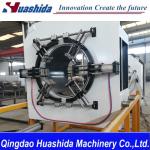High Producing Pre-Insulated Pipe Production Line Screw 75mm Diameter
|
110-550mm PE Insulation Pipe Extrusion Line,Automatic tube cuttinggas/oil /water pipeline Puf Pre-Insulated Pipe PE shell casing plastic Machinery
Technical Prameters:
The huashida insulation pipe production line boasts a core technology that stands at the forefront of China's industry. It showcases numerous innovative points and design concepts, effectively bridging gaps in domestic capabilities. Notably, four pioneering core technologies—the solid-liquid phase separation screw, spiral diverter head, DCL human-machine dialogue technology, and real box external manipulator technology—are either the first or among the earliest implemented in the sector. This groundbreaking product stands as the sole domestic production line capable of producing 1880mm large-diameter insulation pipes, further solidifying its position as a leader in the field. HDPE Jacket Process Flow:
Composition of Equipments:
The production steps of the insulation layer for a pre-insulated pipe, specifically focusing on the polyurethane (PU) foam insulation, are outlined below in detail:
The strong ties between the steel pipe, polyurethane insulation,
and jacket pipe not only provide rigidity but also ensure that the
insulation layer remains in place and performs optimally over its
lifetime. The surface preparation of the steel pipe and the corona
treatment of the HDPE shell contribute significantly to the overall
quality and performance of the pre-insulated pipe.
|
||||||||||||||||||||||||||||||
| Product Tags: Pre Insulated Steel Pipe Production Line Pre Insulated Pipework Production Line Pre Insulation Pipe Production Line |

|
HDPE Pipe Hydraulic Traction Haul-off Machine with Multi-Claw Design |

|
Fully Automatic Chipless Plastic Tube Cutter for Insulated PE Jacketing Pipes |

|
Automatic Planetary Pipe Cutting Machine for Pre-Insulated Plastic PE Jacket Pipe |

|
Polyethylene Jacket Casing Pipe SystemFor 110-1680mm Thermal Pre-Insulated Pipe |

|
Industrial Pipe Cutter for PU Foam Insulated Pipes – High-Speed, Precise Cutting Without Deformation or Saw Teeth |

|
Automatic Pipe Cutting Machine with Planetary Structure and PLC Control – Designed for Pre-Insulated PU Pipe Outer Jacket |



